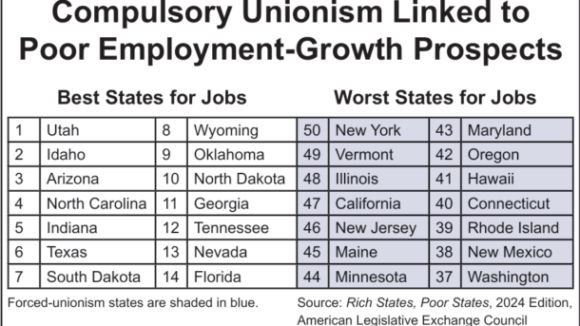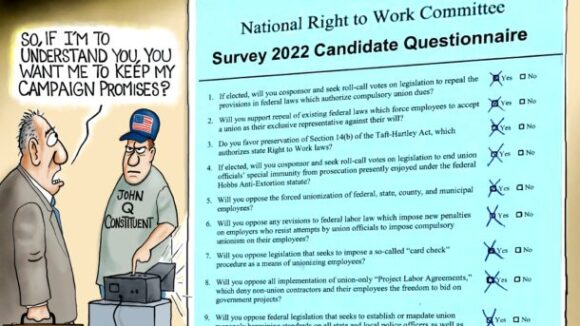Is This Any Way to Run a City’s Schools?
Leaked CTU Proposals Won’t Do Anything to Improve Schools’ Poor Performance

From February 2012 through February 2017, American employees enjoyed the most rapid expansion of Right to Work protections since the 1940’s, with six additional states prohibiting forced union dues and fees as a job condition over the course of just five years.
The primary purpose of state Right to Work laws, now 28 in number, is to protect the employee’s freedom as an individual to join or financially support a union, or refuse to do either.
But the recently enacted Right to Work laws are also fostering faster growth in jobs and rising living standards in the states where they have taken effect.
Unfortunately, protections for employees’ personal freedom have yet to become effective at all in Missouri, where legislators adopted the 28th state Right to Work law a year ago last month.
Though Kentucky’s Right to Work law was signed by Gov. Matt Bevin barely more than a year ago, the Bluegrass State is already becoming an outstanding example of how prohibiting compulsory unionism helps enhance communities’ ability to attract job-creating and income-raising business investments.
Right to Work ‘Translating’Into More and More ‘Wins For Communities Across the State’
On December 30, the Kentucky Cabinet for Economic Development (KCED) announced that the state had attracted a record $9.2 billion in “corporate expansion and new-location projects in 2017, bringing commitments to create more than 17,200 jobs,” the most since 2000.
In his account of the KCED’s year-end report, Jonathan Green of CNHI Kentucky emphasized how rural counties and urban counties alike are benefiting from the Bluegrass State’s investment boom:
“Rural counties attracted 166 [private-sector] projects, while 167 went to the 10 most-populated counties. …”
Mr. Green also specified that the top five sectors for investment in Kentucky in 2017 were “motor-vehicle related, high technology, advanced manufacturing, distribution and logistics, and primary metals.” These are all sectors that typically offer good-paying, family-supporting jobs.
And according to KCED Communications Director Jack Mazurak, his agency has been seeing more inquiries, requests for proposals and site visits from companies ever since the state became Right to Work in January 2017.
Right to Work has translated and “will continue to translate into more wins for communities across the state, new-location projects, and existing industry expansions that create jobs and boost the economy,” said Mr. Mazurak.
Among the employment technology opportunities now headed Right to Work Kentucky’s way are an estimated 875 manufacturing jobs at a $372 million lithium battery plant to be built in Pikeville, an Appalachian town of 7100.
On December 15, executives of EnerBlu, a two-year-old company based in Riverside-San Bernadino, east of Los Angeles, announced plans to move, “lock, stock and barrel,” from forced-unionism California to the Bluegrass State.
The million-square-foot Pikeville plant, which is expected to open in 2020, will be the first in the U.S. to make lithium oxide batteries for transit buses and commercial and military vehicles.
Laws Help Raise Living Standards Partly by Cutting the Cost of Living
EnerBlue simultaneously announced it would locate its new $40 million headquarters, with a projected employment of 110, in Lexington, Kentucky’s second largest city.
As urban policy analyst Wendell Cox has noted, EnerBlu’s major investment in Pikeville “could indicate the potential for ‘cutting edge’ technology to find a home in small towns.”
And small towns in Right to Work states clearly have the advantage over their counterparts in forced-unionism states when it comes to attracting such jobs.
In addition to helping states attract job-creating investments, Right to Work laws help increase families’ real purchasing power. As decades of academic research by economists such as Thomas M. Carroll and Richard J. Cebula have shown, Right to Work laws can improve living standards in part by reducing the cost of living in jurisdictions where they are in effect.
Indiana, which became a Right to Work state six years ago, is a case in point. Indices calculated and published by the Missouri Economic Research and Information Center (MERIC) show that in 2011, the year before Indiana adopted its Right to Work law, the Hoosier State was 20.2% less costly to live in than forced-unionism states on average.
With differences in the cost of living accounted for, Indiana’s per capita disposable income was roughly $1360 higher than the average for Big Labor-dominated states.
By 2016, the average annual cost of living in Indiana was 24.9% below the average for compulsory-dues states.
And Indiana’s cost of living-adjusted per capita disposable income was more than $3800 higher than the average for forced-unionism states.
Until 2013, Michigan’s Workforce Seemed Doomed To Continue Shrinking
The record indicates Right to Work laws can help even states with deeply troubled economies get back on their feet.
In 2012, three years into the national recovery from the recession of 2008-2009, Michigan’s workforce was 230,000 smaller than it had been three years earlier.
Then, in December 2012, Michigan legislators finally heeded the pleas of their freedom-loving constituents by sending to Gov. Rick Snyder’s desk a Right to Work measure, which he promptly signed. It took effect in 2013.
And by the end of 2013, for the first time since 2005, Michigan’s labor force was larger than it had been the year before. The expansion continued in 2014, 2015, 2016 and 2017.
Over the past five years, Michigan has chalked up an absolute gain in payroll manufacturing jobs far greater than any other state, while widening its advantage over the remaining forced-unionism states as a group with regard to real earnings per worker in the sector.
Missouri Workers Miss Out As Right to Work Law Remains in Abeyance
National Right to Work Committee President Mark Mix commented that anyone who takes a careful and unbiased look at the economic records of Indiana, Kentucky, and Michigan since they became Right to Work can see that Big Labor propaganda claims about the impact of prohibiting forced union fees are false.

Mr. Mix surmised that is a key reason why union bosses seeking to kill Right to Work laws invariably aim first, through litigation or other means, to prevent them from taking effect at all.
“Wisconsin and West Virginia have undoubtedly benefited less from their recently-enacted Right to Work laws than they otherwise would have because Big Labor managed temporarily to block them from taking effect through court injunctions issued by union boss-friendly’ judges,” said Mr. Mix.
“And in Missouri, sadly, Right to Work freedoms are still in abeyance today as a consequence of union officials’ exploitation of an obscure provision in the state legal code to block the statute from taking effect.
“Now the only way freedom-loving Missourians can ever enjoy the benefits of their Right to Work law is by defeating an upcoming Big Labor-backed ballot initiative to reinstitute forced union financial support permanently.”
Mr. Mix vowed that Committee leaders and members would do everything reasonably possible to help Missouri citizens get back their Right to Work.
(Click here to download the March 2018 National Right to Work Newsletter)

Leaked CTU Proposals Won’t Do Anything to Improve Schools’ Poor Performance

Wherever Big Labor wields the power to collect forced union dues, union bosses funnel a large share of the confiscated money into efforts to elect and reelect business-bashing politicians. Employment growth tends to lag as a consequence.

Members Insist They Keep Pro-Right to Work Campaign Promises